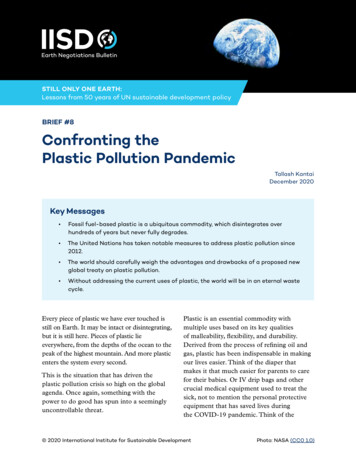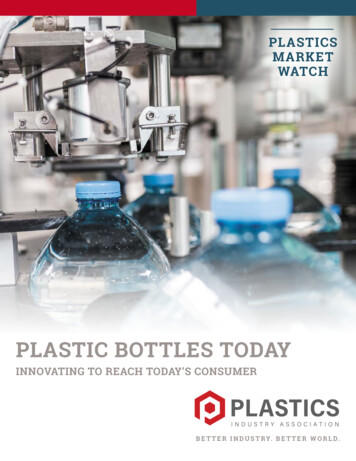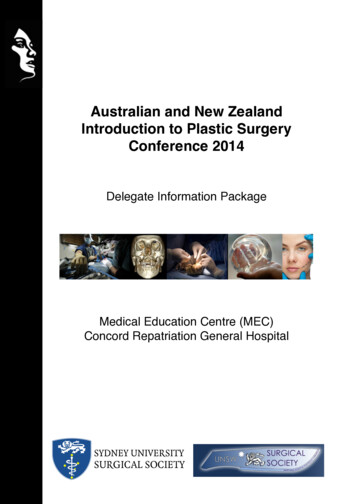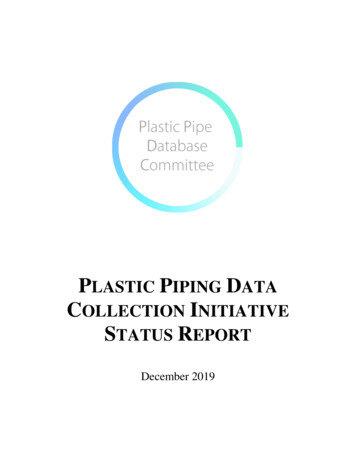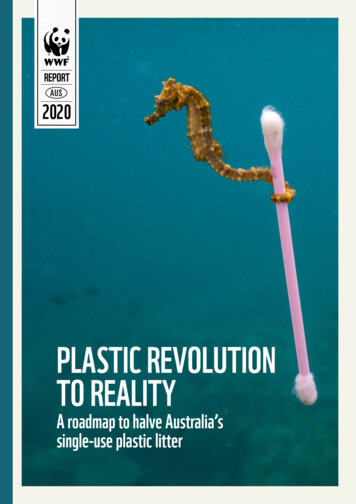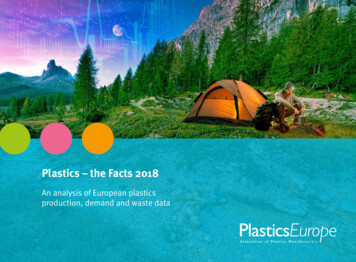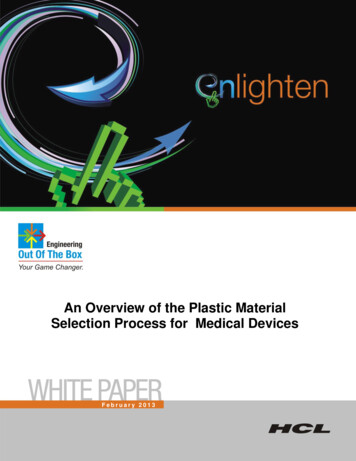
Transcription
An Overview of the Plastic MaterialSelection Process for Medical DevicesFebruary 2013
An Overview of the Plastic Material Selection Process for Medical Devices February 2013TABLE OF CONTENTSAbstract . 3Abbreviations . 4Market Trends/Challenges . 5General Guidelines for Material Selection . 6Material Selection Flowchart . 20Benefits of Pre-Material Selection . 22Conclusion. 23References . 24Author Info: . 25 2013, HCL Technologies. Reproduction Prohibited. This document is protected under Copyright by the Author, all rights reserved.
An Overview of the Plastic Material Selection Process for Medical Devices February 2013AbstractThe current market trend toward increased safety and quality at areasonable cost has urged the medical industry to select biocompatible, clean, and environmentally-friendly materials to meetsafety, manufacturability, and functionality requirements for medicalproducts. At the same time, these requirements pose constraintsand challenges on the materials selected during productdevelopment for medical devices and instruments.Applications in the healthcare industry and medical devices inparticular, have some demanding requirements for thermoplasticmaterials that are unique to this arena. While polymers have beenused in the healthcare industry for decades, it has only been in therecent past the designers have started to explore the benefits ofusing special compounds in medical applications.Metal has been the traditional material of choice for orthopedic orany surgical instrumentation, but new plastic resins, combined withscientific process development and validation, are now makinginroads into those markets.Unique technologies related to anti-static, raidopacic, wear-resistantand elastomeric compounds that have made an impact in otherindustries are just now finding their way into medical devices.This paper presents an overview of the plastic material selectionprocess, with specific emphasis on the unique requirements ofmedical applications. 2013, HCL Technologies, Ltd. Reproduction prohibited. This document is protected under copyright by the author. All rights reserved.3
An Overview of the Plastic Material Selection Process for Medical Devices February 2013AbbreviationsSl. No.Acronyms(Polymers)Full Form1ABSAcrylobutadiene 5PSUPolysulfone6PPSUPolyphenyl sulfone7PMMAPolymethyl methacrylate (Acrylic)8PEPolyethylene9UHMWPEUltra high molecular weight polyethylene10LDPELower density polyethylene11PAPolyamide (Nylon)12LCPLiquid cystaline polymer13PARAPolyaryl amide14PPSPolyphenyl sufide11PEEKPolyether etherketone12PVCPolyvinyl chloride13PETPolyethylene terephthalate14PTFEPolytetra flouroethylene (Teflon) 2013, HCL Technologies, Ltd. Reproduction prohibited. This document is protected under copyright by the author. All rights reserved.4
An Overview of the Plastic Material Selection Process for Medical Devices February 2013Market Trends/ChallengesMaterials, whether metal or plastic, have always limited design sinceman first built shelters, made clothes and undertook human conflict.But right now, materials and the processes to shape them aredeveloping faster than at any time in history; the challenges andopportunities are therefore greater than ever before. This paper isabout strategies/guidelines for exploiting plastic materials fororthopedic instruments and medical devices design.Medical devices and instruments are in a constant state ofevolution, responding to trends within and outside the hospitalenvironment to achieve better care at lower system costs. In today‟sworld, as far as medical device design is concerned, safety ofhuman life is the prime objective.The trends toward miniaturization and portability are driving newrequirements for housings and drug-coated implants. Cleanlinessand sanitation continue to receive strong attention globally, requiringdevices to withstand a range of chemicals and sterilizationtechniques. Reusability of a product was considered as a leapahead advantage once, but not any more in the medical industry,especially in orthopedics.The use of single-use instrument is a solution and is the latest trendin orthopedics. This may force the industry to go for plastic materialsby which the cost can be reduced to an extent.But there are still concerns over the desired mechanical properties,biodegradability, sterilizability and radiopacity of the materials usedthat need to be looked at in detail. 2013, HCL Technologies, Ltd. Reproduction prohibited. This document is protected under copyright by the author. All rights reserved.5
An Overview of the Plastic Material Selection Process for Medical Devices February 2013General Guidelines for Material SelectionMaterial selection is often one of the most intimidating andconfusing hurdles encountered by medical device designers. Thereseem to be hundreds of polymers to choose from, but where do westart?The material selection process requires a preliminary understandingof polymers, additives and their properties. Of primary importance isa basic understanding of polymer morphology and the propertiesdifferent morphologies bring to the picture. Thoroughly definedapplication requirements are needed to select appropriate candidatematerials. After careful consideration, the possibilities can benarrowed down to two or three candidates, and the final selectionshould be determined by testing. It follows the steps below:1) Translation: Express design requirements as constraints andobjectivesThe following list of queries or considerations should be used todefine the application or requirements as much as possible. In manycases the answers to these criteria will be helpful to eliminate aparticular plastic or an entire family of plastics. The more completelythe application of medical device/instrument is defined, the betterthe chance of selecting the best materials for the application.Environmental exposure considerations: Should the material be biocompatible? Will the component be in contact with body tissues or drugs? Ifso, for how long? Is the product a single use instrument/device? Will the component undergo sterilization? If so, which method ofsterilization will be used? How frequently will it be sterilized? Will any other chemicals/solvent vapours be in contact with theproduct (wiped/submerged) as part of hospital cleaning? Will the device be painted/electroplated /glued? To what humidity and temperature (maximum and minimum) willthe product be exposed? How long will it be exposed? Is dimensional stability in a wet or humid environment critical?What tolerances must be met? Is UV resistance needed? Does the device need to be visible under a fluoroscope or X-ray? Is flame retardability a requirement? Is the colour of the material is an important factor? Will the part be used outdoors? 2013, HCL Technologies, Ltd. Reproduction prohibited. This document is protected under copyright by the author. All rights reserved.6
An Overview of the Plastic Material Selection Process for Medical Devices February 2013Functional and Mechanical Considerations: What are the overall parts dimensions (diameter, length, width,thickness)? Is dimensional stability a factor to be considered? What load will the part have to carry? How long will the load tobe applied? Will the load be continuous or intermittent? What is the maximum stress on the part? What kind of stress is it(tensile, flexural, etc.)? Is toughness or impact resistance critical during use? Will the material be used as a bearing? Will it need to resistwear? What wear or abrasion conditions will the material see? Is the product going to be used as an electrical insulator? What are the manufacturing processes/options available? If it is a molded component, does it make use of any of thesetechniques: micro molding, over moulding, insert molding, gasassisted molding or in-mold decoration? What is the target cost of the component? What is the projected life of the part or design? What other mechanical properties are required? Are static dissipation/conductivity/dielectric properties required? Which manufacturing technique is going to be used for producingthe final component?2) Screening: Analyze and follow the guidelines to shorten theselection process. The selection should be based on polymersmeeting both the environmental and mechanical/physicalrequirements.a) One of the first requirements to be considered for medical devicepolymer selection is biocompatibility of the polymer materialwhich comes under environmental exposure consideration.When components are subjected to contact with bodytissue/fluids, the components must be biocompatible. Twocommon biocompatibility test standards are USP class VI and ISO10993, the latter being more stringent and suited for medicaldevices.ISO 10993-1 specifies that process contaminants, residues, anddegradation of products should be taken in to account while doingbiocompatibility tests.The table below shows biocompatibility test requirements per ISO10993-1 for different medical products, based on their application. 2013, HCL Technologies, Ltd. Reproduction prohibited. This document is protected under copyright by the author. All rights reserved.7
An Overview of the Plastic Material Selection Process for Medical Devices February 2013Selection of the tests per ISO 10993-1 BoneBloodCABCABCAxxxx x x xxxxx xxxx xxxxx x xxx - Test to be included to ISO 10993-1 additional tests may be applicableA short term ( 24h)B protracted ( 24h to 30d)C continuous ( 30d)* The data shown in the table is taken from www.roechling-plastics.usIn this case, however, the major concern is how the compoundaffects its environment, namely internal body tissues and fluids.Recently, polymers have been introduced for hip socketreplacement in orthopedic applications due to their closeresemblance to the natural polymeric tissue components.However, polymers undergo degradation in the body environmentdue to biochemical and mechanical factors. This results in ionicattack and formation of hydroxyl ions and dissolved oxygenleading to tissue irritation, inflammation and other reactions withbodylike corrosion and wear. 2013, HCL Technologies, Ltd. Reproduction prohibited. This document is protected under copyright by the author. All rights reserved.8Biodegradation xReproductiontoxicity xCanceroginity HemocompatibilityChronicaltoxicityIrritation xxxSub chronictoxicityMedicalproductscoming intocontact withthe interiorof the bodyfrom outsideMucousmembranexxxxxxxxxxxxxxxxABCABCAAcute toxicityMedicalproductswith contactto bodysurfacesSkinSensitizationNature of the physicalcontactDuration ofcontactCytotoxicityBiological Risks
An Overview of the Plastic Material Selection Process for Medical Devices February 2013There are steps to be taken at the beginning of development toidentify potential raw material candidates that have a highlikelihood of passing biocompatibility testing.Only a small number of polymers are available as medical gradefor medical application, and an even smaller number is used forimplants. The choice of polymer depends on the extent of contactwith body fluids, internal and external tissue as prescribed by theregulatory framework.The table below shows the polymers that can select based on theapplicationSl.NoApplication of medicaldevices1Non-contact withhuman body, e.g.syringes, blood storagebags, glucose drip bagsPVC,PA,PE,PS, Epoxyresins2Short-term contactwith human body, e.g.catheters, feeding tubes,drainage tubes, surgicalinstrumentsSilicone rubber, Naturalrubber, PVC, Polyurethane,PE, PP, Polyester, PEEK,Polyphenylsulfone, Nylon,Teflon, PeBax3Medium term contactwith human body, e.g.cultures, ligaturesNylon, PP, Polyester4Long term contact withhuman body, e.g.implants, drug deliverydevicesPolymer selectionPE, UHMWPE, PET,Silicone rubber,Polyurethane, PMMA,Polysulphones, HydrogelsPolyphosphazenes,Thermoplastic elastomers,PolydimethylsiloxaneIf a component is subjected to body tissue or fluid contact, thenext question is how long it is in contact. This can be divided intothree types. If it is 1 day, it is termed as short-term or limited. Ifthe contact is between 1 and 30 days, it is termed as mediumterm or prolonged. If it is 30 days, it is termed as long-term orpermanent. Plastics subjected to fluid contact for longer periodsneed to have low permeability, as many MIS devices haveelectronic circuitry enclosed. 2013, HCL Technologies, Ltd. Reproduction prohibited. This document is protected under copyright by the author. All rights reserved.9
An Overview of the Plastic Material Selection Process for Medical Devices February 2013b) Another consideration when selecting a polymer in line with theabove mentioned is related to the drug flow path, i.e. when thematerial is in direct contact with the flow of drugs through adevice. The concerns for this situation are similar to thetissue/fluid contact concerns mentioned earlier, except we nowneed to look at the effect the material has on drugs as opposed tothe body.Again, chemical resistance is important, as the drugs should notpromote the material‟s degradation. It is also undesirable to havethe potency of the drug affected by the thermoplastic compound itis in contact with, either via extraction of additives and monomersor via the chemical reactivity between the drug and the polymer.Extraction and biocompatibility data are often reviewed in such acase, and a drug master file may be utilized to convey theconfidential information to the FDA on the materials for theapplication.c) Another important requirement that most medical devices shouldbe compatible with is sterilization compatibility. Plastic devicesthat require body tissue/fluid contact must undergo sterilization.Plastics react differently to various sterilization methods. The mostcommon sterilization methods are radiation (gamma/e-beam),chemical (ETO) and autoclave (steam).The majority of thermoplastic polymers can withstand exposure totoxic Ethylene oxide (ETO) without significant changes to theirproperties or colour during sterilization.However, plastics subjected to radiation sterilization will beaffected, and it may change the mechanical properties of thematerial such as tensile strength, impact strength and elongationby chain scission or cross-linking. It is also important to note thatmultiple exposures to radiation are cumulative. Radiation resistantthermoplastics include styrenic thermoplastics such as ABS,PARA, PEEK, PEI, PES, PSU, PPSU and TPU. In terms ofmechanical performance, PC is generally resistant to radiation,but it will discolour with radiation exposure. There are someantioxidant packages that can be used to improve the radiationstability of certain polymers, but the best course of action is toselect polymers that are known to perform well.Autoclaving, or steam sterilization, uses a combination of heatand moisture for repeated cycles of 3-15 minutes to kill germs.Parts that are molded with high residual stress levels may beginto see some stress relaxation (annealing), and therefore can havedimensional instability or can warp when exposed to hightemperatures of 121⁰C to 140⁰C. The amorphous grade materialsare more suitable due to their tendency to warp less. Materialslike PP, PA, PC and PSU can be used, but care must be taken asto how many cycles they will be exposed to. The best polymers 2013, HCL Technologies, Ltd. Reproduction prohibited. This document is protected under copyright by the author. All rights reserved.10
An Overview of the Plastic Material Selection Process for Medical Devices February 2013for resistance to autoclaving are PPSU and PEEK, with bothpolymers able to handle exposure to thousands of cycles. Somepolyethylenes can be autoclaved, but only at lower temperaturesand for limited lengths of time due to their low resistance totemperature. Families of polymers like styrenes (ABS, PS) andpolyesters (PBT or PET) are poor candidates for autoclaving dueto poor resistance to the heat/moisture environment.If the product is not a single-use device, its components will besubjected to multiple sterilizations before being discarded, soplastics which possess superior toughness with a lesser tendencyto discolor (PEEK, PEI, PSU, PPSU and PC) are better choices.The table below gives an idea about sterilizable polymers withrespect to the method of sterilizationSterilization resistanceMaterialPolymerPolystone P MGPP- HSUSTARIN C MGPOM-CSUSTAPEEK MGPEEKSUSTASON PSU MGPSUSUSTASON PPSU MGPPSUSUSTAPEI MGPEISUSTANAT PC MGPCSterilization procedureHotHot steamair250 F 273 F 356 FVery good resistanceConditional resistance*Ethyleneoxide140 FPlasma113 FGammaraysRTGood resistanceNo resistance* The data shown in the table above is taken from www.roechlingplastics.usd) Resistance to hospital cleaners (chemicals): Routine cleaningbrings many devices into repeated contact with a wide variety ofdisinfection chemicals. Each exposure may contribute todeterioration of the plastics, and can have detrimental effects onpart performance. Cleaners such as isopropyl alcohol, bleachesand peroxides may attach to the polymer chains of somethermoplastic resins and cause crazing, stress cracking or evenbreakage.Chemical resistance is a polymer property, and no additives orreinforcements will significantly change the resistance of apolymer to a given chemical. Generally, semi-crystalline polymerslike PP, PE and polyamides will have better chemical resistancethan amorphous polymers like ABS and PC. But there can beexceptions: exposure of polycarbonate to hydrogen peroxideyields a fairly stable result while similar Nylon 6 exposure results 2013, HCL Technologies, Ltd. Reproduction prohibited. This document is protected under copyright by the author. All rights reserved.11
An Overview of the Plastic Material Selection Process for Medical Devices February 2013in swelling and a loss of mechanical properties. So, it is alwaysimportant to verify the performance with the data sheet rather thangoing behind general facts.RESISTANCE TO HOSPITAL CLEANERS (CHEMICAL)IMIDIZEDMATERIALS PAI(Polyamide-imide) VespelPolymideshapesSEMICRYSTALLINE THERMOPLASTICS AcetalHDPELDPENylonPBTPEEK PETPolypropylenePPSPTFEPVDFUHMW-PEe) Mechanical properties (tensile and compressive strength,bending stiffness, impact strength, wear resistance, etc.):Selecting a plastic material is based on a number of traditionalmaterial requirements such as strength, stiffness or impactresistance. Engineered thermoplastics like PC, PEEK, PPSU,POM, nylon, poly acetal, etc., show excellent mechanicalproperties at low and high temperatures. These properties arerequired for a variety of climate conditions, including duringtransportation, where the influence of temperature on drop impactmay result in different outcomes for device integrity.The concept of miniaturization is another factor which helpsdecide plastic material selection. To reduce patient trauma andimprove the safety and effectiveness of surgical procedures,some surgical instruments have been significantly redesigned foruse in minimally invasive surgery. Materials such as polyetheramide (PEI) resins are designed to provide high strength andstiffness for the management of higher loads on components suchas gears.Material selection is also influenced by other factors like wearpairs (a combination of materials in contact with each other), wearconditions/medium (ex: wet or dry) and wear configurations (ex:rotary, sliding, oscillatory, etc). Lubricity improves wearresistance.The tables below show the details of tensile strength, bendingstiffness and toughness for different plastic materials. 2013, HCL Technologies, Ltd. Reproduction prohibited. This document is protected under copyright by the author. All rights reserved.12
An Overview of the Plastic Material Selection Process for Medical Devices February 2013*Mechanical, electrical and thermal data shown in the tablesbelow are taken from www.curbellplastics.comMECHANICAL PROPERTIES – TENSILE STRENGTH*AMORPHOUS THERMOPLASTICSSEMICRYSTALLINE THERMOPLASTICSTensile Strength (psi)Tensile Strength (psi) UltemPolysulfoneRadel RAcrylicNorylPolycarbonatePETGPVCR KydexABSPolystyrene 6,1004,1003,500 PEEK14,000Nylon (6cast)10,000-13,500PPS12,500Nylon (6/6 e (Homopolymer) 5,400HDPE4,000Polypropylene 00MECHANICAL PROPERTIES – FLEXURAL MODULUS*AMORPHOUS THERMOPLASTICSSEMICRYSTALLINE THERMOPLASTICSFlexural Modulus - Stiffness (psi)Flexural Modulus - Stiffness (psi) PVCUltemAcrylicPolysulfoneNoryl Radel RPolycarbonateKydexPolystyrene (HIPS)PETGABS304,000 0350,000345,000335,000310,000310,000 PPS600,000PEEK590,000Nylon lon (6/6 000UHMW-PE110,000PTFE72,000LDPE30,000 2013, HCL Technologies, Ltd. Reproduction prohibited. This document is protected under copyright by the author. All rights reserved.13
An Overview of the Plastic Material Selection Process for Medical Devices February 2013MECHANICAL PROPERTIES – TOUGHNESS*AMORPHOUS THERMOPLASTICSSEMICRYSTALLINE THERMOPLASTICSIzod Impact (notched) toughness(ft-lbs/in)Izod Impact (notched) toughness(ft-lbs/in) KydexPolycarbonateRadel RABSNorylPolystyrene 3.07.73.52.01.71.31.01.00.4 LDPEno breakUHMW-PE18.0Polypropylene (copolymer)12.5PTFE3.5PVDF ropylene (Homopolymer)1.2Nylon (6/6 extruded)1.2Acetal(Copolymer)1.0Nylon (6cast)0.7-.9PET0.7PPS0.5Electrical and Thermal Properties (dielectric strength andthermal resistance): Enclosures for medical devices may requirehigh heat resistance, electrical properties such as dielectricstrength, etc. Engineered thermoplastics like PC, PC blends,polyphenylene, polystyrene blends, etc., show excellent electricalproperties at all temperatures. The tables below show the detailsof dielectric strength, heat resistance and its relation to costs.ELECTRICAL PROPERTIES*AMORPHOUS THERMOPLASTICSSEMICRYSTALLINE THERMOPLASTICSDielectric Strength – Insulation (v/mil)Dielectric Strength – Insulation (v/mil)Ultem830Nylon el R360Nylon (6/6 extruded)PVDF500-600400-500300-400280 2013, HCL Technologies, Ltd. Reproduction prohibited. This document is protected under copyright by the author. All rights reserved.14
An Overview of the Plastic Material Selection Process for Medical Devices February 2013THERMAL PROPERTIES *AMORPHOUS THERMOPLASTICSSEMICRYSTALLINE ANCERESISTANCEHIGHESTHIGHESTRadel RPPS Ultem PPSUltemNylon Radel R PEEKPolysulfoAcetal Polysulfone PVDFnePolycarboPBT Noryl PTFEnateNorylPVDF Polycarbonate PET AcrylicPTFE ABS PBTPolystyre PolystyrenePET Nylonne (HIPS)(HIPS)ABSPolypropylene Kydex AcetalKydexHDPE PVC UHMW-PEPVCLDPE PETG HDPEPETG Acrylic LDPE PolypropyleneLOWESTLOWESTf) Other factors for material selection:Dimensional stability: Tight tolerance is often another keyproperty for miniaturized internal components. The functionality ofthe device may depend on the precise interaction of itscomponents. The section of materials for dimensional stability canbe even more complex, considering the variety of operatingenvironments which may include exposure to chemicals and hightemperatures. Amorphous plastics have low, uniform shrinkagethat provides good dimensional stability and low warpage to holdtight tolerances in complex components. Dimensionally stableplastics include PC, PEI, PES, PSU and PPSU. Semi-crystallineplastics have higher, less uniform shrinkage but fillers can beused to retard shrinkage. Liquid crystal polymer (LCP) has one ofthe lowest shrink rates and provides excellent dimensionalstability.Durability and Aesthetic: Devices designed for hospital use areoften shared, and may need to be transported from one clinicalarea to another, so durability of the plastic enclosure is importantin the selection of material. ABS, PC and PC-ABS blends arecommonly used in housing components. Another importanthealthcare trend focuses on providing a reassuring and pleasantenvironment for patients. Molded-in colors and effects areavailable directly from resin suppliers, and can eliminate the cost 2013, HCL Technologies, Ltd. Reproduction prohibited. This document is protected under copyright by the author. All rights reserved.15
An Overview of the Plastic Material Selection Process for Medical Devices February 2013of secondary operations including painting. Color technologies likechroma shift, metallic and even glow-in-the-dark can add aperceived value that is beyond their cost. ABS is used whereelectroplating is required.Radiopacity: Certain additives can be used to make a polymerradiopaque, that is, able to be seen by X-ray imaging orfluoroscope. This technique is useful in surgical implants, andcatheters that need to be seen during surgery. Barium sulfate isthe most common additive used to obtain radiopacity. TungstenBismuth based minerals like bismuth sub-carbonate and bismuthtrioxide can also be used, though they are costlier options.Conductive: In some dry powder and aerosol drug deliveryapplications, static build-up on the surface of thermoplastic partcan attract the drug and cause incorrect dosages. The use ofpermanently antistatic compounds in these applications reducesor eliminates static build-up and allows accurate dosing.Compounds based on acrylic, polypropelene, clear ABS, ABS PCblends, etc., are commonly used in these types of devices.Lubrication: Many devices that have any plastic-on-metal orplastic-on-plastic sliding parts need to have high wear resistance.Gears, implants, and sliding covers are all examples of this.UHMWPE shows high wear resistance, and it can be improvedthrough a process called cross-linking, which creates strongerbonding between the molecular chains that make up thepolyethylene. Additives like PTFE and silicone are commonlyused to improve lubricity and wear resistance of a plastic material.Manufacturing feasibility: This is another factor, based onwhich plastic materials need to be identified for a particularproduct, the same way thermoplastic and thermosetting plasticsare produced using different manufacturing processes.It is all very well to choose the perfect material, but somehow wehave to make something out of it as well! An important part ofunderstanding a product is to consider how it was made. In otherwords, what manufacturing processes were used, and why?There are two important stages to selecting a suitable process: Technical performance: Can we make this product withthe material, and can we make it well? Economics: If we can make it, can we make it cheaplyenough?The table below provides a brief introduction to the variousmanufacturing methods by which a plastic material product can bemanufactured. 2013, HCL Technologies, Ltd. Reproduction prohibited. This document is protected under copyright by the author. All rights reserved.16
An Overview of the Plastic Material Selection Process for Medical Devices February 2013* Acrylic Cellulose acetate Nylon Polyimide Polycarbonate Polyethylene Polystyrene Polysulfone Polyurethane Polypropylene PVC Polyvinyl acetate Tetrafluoroethylene So, to summarize the table below provides basic information toinitiate the selection of plastic materials for medical devices. 2013, HCL Technologies, Ltd. Reproduction prohibited. This document is protected under copyright by the author. All rights reserved.17CALENDERING PULTRUSION VACUUM MOLDINGABSREINFORCED PLASTICMOLDING FOAM MOLDING FORGINGTHERMOFORMING CASTINGBLOW MOLDING INJECTION MOLDINGROTATIONAL MOLDING REACTIONEXTRUSIONAcetalMATERIALTRANSFER MOLDINGINJECTION MOLDINGCOMPRESSION MOLDINGManufacturing data shown in the table below is taken fromwww.mikrotech.com
An Overview of the Plastic Material Selection Process for Medical Devices February PPS 2013, HCL Technologies, Ltd. Reproduction prohibited. This document is protected under copyright by the author. All rights reserved.18 RadiationEtO Autoclave Micromachining FriendlyHigh Flow into Thin Walls USP Class VI Lase Friendly ISO 10993Wear
about strategies/guidelines for exploiting plastic materials for orthopedic instruments and medical devices design. Medical devices and instruments are in a constant state of evolution, responding to trends within and outside the hospital environment


